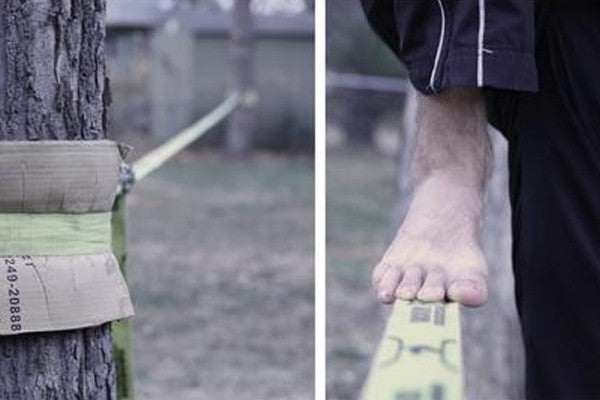Learn How to Slackline
November 17, 2016


So you want to learn how to slackline, huh? With roots in the 70s in Yosemite Valley, this sister sport of tightrope walking is excellent cross training for climbing, skiing and snowboarding, yoga, and more. You’ll gain balance, strengthen your core, and hone your ninja skill set in the process. Plus, it’s a fun and easy way to get outside for a great adventure.
Things you’ll need:
- A slackline (you can buy a kit from several retailers, or make your own primitive line). It’s recommended to start on a shorter line – 15 to 20 ft or so. The short distance allows you to keep the line nice and tight.
A note on choosing anchor points: trees are the most common anchors, but be sure to choose a tree that’s at least 1 ft in diameter. Other great options are concrete pylons, telephone poles, maybe even the trailer hitch of your vehicle. Set your line up between knee and thigh height.
- Tree protection - strips of carpet, cardboard, towels, etc. all work great to protect the tree from the friction where the anchor slings meet the bark.
- Another human – seriously, bring a slackline partner for best results. They can help you stabilize the line, stabilize yourself, but most importantly, they’ll make sure you don’t take yourself too seriously. Because you’re going to look pretty goofy, and you’re going to fall. A lot.
x
So - let’s start with the basics! Standing up.
Start barefoot if possible – this is going to help you develop the tiny stabilizer muscles in your feet that you need to stay upright and steady. Position yourself a few feet away from one of the anchors, facing the other end of the line, and put one foot up. The slackline should run under the ball of your foot and off your heel – do not put your foot perpendicular to the line!
Take a deep breath, gaze firmly at the anchor across from you, and go for it! Stand up on your one leg and see what happens. Fall off? Switch legs and try again, and repeat until exhausted.
Tip #1: Slackline position
When you stand up on the line, keep your standing leg slightly bent, stacking hips over feet, shoulders over hips. Try to keep your shoulders and hips squarely facing the opposite anchor.
Don’t look down. Your eyes should only ever be in one of two places while slacklining: on one anchor, or on the other anchor.
Arms should be overhead – use them, as well as your free leg, as three counterbalances to keep you upright.
Try to rest your weight passively in your standing leg, rather than pushing down on the line. The downward push actually causes the slackline to start wobbling violently. (We know this doesn’t seem like it makes any sense or difference – but it seems to really help!)
Tip #2: Use your buddy!
Remember your friend? They can provide some extra stabilization while you’re learning to stand. Have your friend sit in the middle of the line with their feet firmly planted on the ground. This will help to stabilize some of the wobbles while you learn to catch your balance.
Tip #3: Don’t try to walk.
What?! But isn’t that the whole point?!! Well, yeah, but it’s going to be loads easier if you can balance and stand upright. Repeat the exercise above until you can stand for 10-15 seconds on each foot without falling off the line – you’ll be surprised how fast you get to this point. Once you’ve nailed standing, then you’re ready for your first steps.
x

x
Walking on the slackline
Okay, so you’ve mastered (ish) standing on both your left and your right legs on the slackline. Now walking is easy - you just have to go from standing on your right, to standing on your left leg, and repeat!
Make sure you’re walking with your feet inline, rather than sideways, and keep your shoulders square to the opposite anchor. The line will get much shakier as you get closer to the center. When you start to fall – fight it! The longer you stay on the line, the faster you develop your balance muscles.
x
Okay, I’m walking! What’s next?
The possibilities on a slackline are nearly endless. Try turning around at the end of the line, or jumping from the ground up onto the line. Walking backward is a fun way to challenge yourself too.
If you’re interested in preparing for longlining or highlining, you’re going to want to figure out how to stand up from a seated position on the line (then try to sit from a standing position). There are a few methods of standing, most notably the Chongo (named for a famous Yosemite dirtbag).
You can try your yoga practice on the line, drop one or both knees below the line, lie down, walk with your eyes closed, or try jumping on with a friend.
Most importantly, don’t forget to have fun! Slacklining is an extremely social sport and a great way to meet like-minded adventurers. Check out slackline and climbing meetups in your area, or invite new friends to join you with your new setup.
x
We’d love to see shots of your most picturesque slacklining spots! Tag us on social @matador.up and don’t forget to #putyourselfoutthere


0 comments